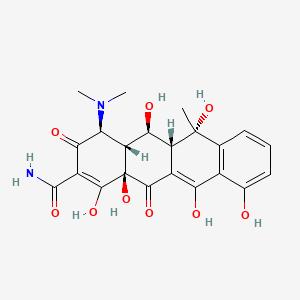oxytetracycline
oxytetracycline is a lipid of Polyketides (PK) class. Oxytetracycline is associated with abnormalities such as Infection, X-linked centronuclear myopathy, Bacterial Infections, Heart failure and Onchocerciasis. The involved functions are known as Anabolism, physiological aspects, Transcription, Genetic, Fermentation and Transcriptional Activation. Oxytetracycline often locates in Chromosomes, Flank (surface region), Entire bony skeleton, Bone Marrow and Body tissue. The associated genes with oxytetracycline are Polypeptides, Homologous Gene, Gene Clusters, Locus and CYCS gene. The related lipids are LH 1 and Lipid Peroxides. The related experimental models are Disease model.
Cross Reference
Introduction
To understand associated biological information of oxytetracycline, we collected biological information of abnormalities, associated pathways, cellular/molecular locations, biological functions, related genes/proteins, lipids and common seen animal/experimental models with organized paragraphs from literatures.
What diseases are associated with oxytetracycline?
oxytetracycline is suspected in Infection, Helminthiasis, Nodule, Bacterial Infections, Yeast infection, pathologic fistula and other diseases in descending order of the highest number of associated sentences.
Related references are mostly published in these journals:
| Disease | Cross reference | Weighted score | Related literature |
|---|
Possible diseases from mapped MeSH terms on references
We collected disease MeSH terms mapped to the references associated with oxytetracycline
PubChem Associated disorders and diseases
What pathways are associated with oxytetracycline
There are no associated biomedical information in the current reference collection.
PubChem Biomolecular Interactions and Pathways
Link to PubChem Biomolecular Interactions and PathwaysWhat cellular locations are associated with oxytetracycline?
Visualization in cellular structure
Associated locations are in red color. Not associated locations are in black.
Related references are published most in these journals:
| Location | Cross reference | Weighted score | Related literatures |
|---|
What functions are associated with oxytetracycline?
Related references are published most in these journals:
| Function | Cross reference | Weighted score | Related literatures |
|---|
What lipids are associated with oxytetracycline?
Related references are published most in these journals:
| Lipid concept | Cross reference | Weighted score | Related literatures |
|---|
What genes are associated with oxytetracycline?
Related references are published most in these journals:
| Gene | Cross reference | Weighted score | Related literatures |
|---|
What common seen animal models are associated with oxytetracycline?
Disease model
Disease model are used in the study 'A molecular ecological approach to the detection and designation of the etiological agents of a model polymicrobial disease.' (Antiabong JF et al., 2013).
Related references are published most in these journals:
| Model | Cross reference | Weighted score | Related literatures |
|---|
NCBI Entrez Crosslinks
All references with oxytetracycline
Download all related citations| Authors | Title | Published | Journal | PubMed Link |
|---|---|---|---|---|
| Bousek J et al. | Behaviour of doxycycline, oxytetracycline, tetracycline and flumequine during manure up-cycling for fertilizer production. | 2018 | J. Environ. Manage. | pmid:29960191 |
| Conde-Cid M et al. | Biotic and abiotic dissipation of tetracyclines using simulated sunlight and in the dark. | 2018 | Sci. Total Environ. | pmid:29710673 |
| Cheng D et al. | Quantitative models for predicting adsorption of oxytetracycline, ciprofloxacin and sulfamerazine to swine manures with contrasting properties. | 2018 | Sci. Total Environ. | pmid:29660871 |
| Zhou K et al. | Photocatalytic Degradation of Oxytetracycline by Ternary Mixed Catalyst and Toxicity Assessment Using Boar Sperm. | 2018 | J Nanosci Nanotechnol | pmid:29448494 |
| Cambronero-Heinrichs JC et al. | Removal of herbicides in a biopurification system is not negatively affected by oxytetracycline or fungally pretreated oxytetracycline. | 2018 | Chemosphere | pmid:29421730 |
| Ding R et al. | Light-excited photoelectrons coupled with bio-photocatalysis enhanced the degradation efficiency of oxytetracycline. | 2018 | Water Res. | pmid:30015099 |
| Zhang X et al. | On the rules of continuity and symmetry for the data quality of street networks. | 2018 | PLoS ONE | pmid:30001374 |
| Wu Y et al. | Performance of bimetallic nanoscale zero-valent iron particles for removal of oxytetracycline. | 2018 | J Environ Sci (China) | pmid:29941253 |
| Jiménez-Gamboa D et al. | Expanding the application scope of on-farm biopurification systems: Effect and removal of oxytetracycline in a biomixture. | 2018 | J. Hazard. Mater. | pmid:28886567 |
| Cao J et al. | Hyphospheric impacts of earthworms and arbuscular mycorrhizal fungus on soil bacterial community to promote oxytetracycline degradation. | 2018 | J. Hazard. Mater. | pmid:28802245 |
